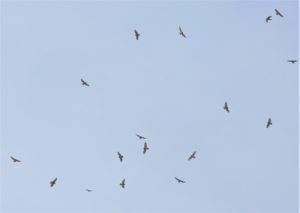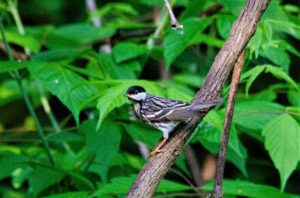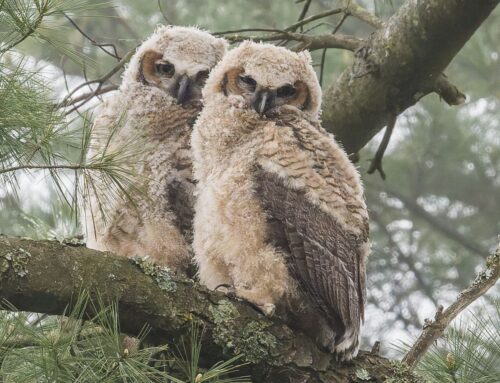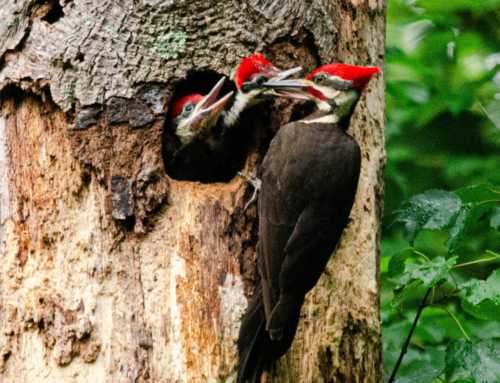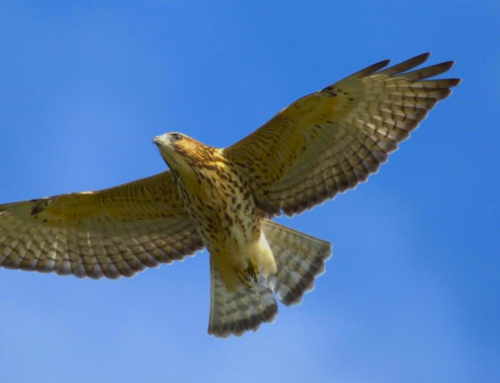Ah, migration! The season is in change. Zugunruhe* (a German word for the restlessness birds display before migration) is all around. In spring, birders delight in the passage of brightly plumaged warblers, vireos, orioles, and the songs they bring. Shorebirds, sparrows, and especially raptors are the focus of fall migration. Hawk watchers scan the skies in mid to late September to catch a large “kettle” of broad-winged hawks that may contain hundreds or even thousands of birds. Migration is a time to witness the magic of nature on display.
Of the more than 700 species of breeding birds in North America, more than half of them are seasonal migrants. In terms of distance, Arctic terns are among the champions. They breed as far north as the Arctic Ocean and annually migrate to the Antarctic ice packs to enjoy the Southern Hemisphere “summer”. This is a round trip of some 25,000 miles per year, not counting miles flown while foraging along the way. Arctic terns have an average life span of over 30 years so that’s a lot of lifetime air miles. The current world record holder for non-stop migratory flight is a Bar-tailed Godwit that was recorded flying without rest for eleven days from Alaska to New Zealand, a distance of 7500 miles.
Songbirds and shorebirds usually migrate at night when winds are less turbulent and they are protected from predators. Nocturnal flight also leaves daylight available for feeding. Daytime migrants like hawks, eagles and other raptors take advantage of the lift from rising air thermals created as the sun warms the earth.
Migration is a long, arduous journey and bird mortality during the trip is high. So why make this journey at all and how did migration evolve? Birds that migrate north to breed raise more chicks per brood than their counterparts who stay in the tropics. The abundant food supply that erupts in the Northern Hemisphere spring promotes breeding success and makes migration worth the risk.
Seasonal change in the availability of resources appears to be the main driver of the evolution of migration. A leading theory is that migration evolved through the gradual extension of small annual movements in search of food or nesting habitat. As this migratory behavior was passed on through generations, gradually longer distances evolved. The evolutionary process was likely accelerated by the push and pull of the more than twenty glacial cycles that have occurred over the past 2.5 million years.
How do migrating birds find their way? Despite what many of us have been told, birds don’t really have compass-like magnets in their brains, but they do use the earth’s magnetic fields to aid navigation by a method embedded in the mysteries of Einsteinian physics. Research shows a migrating bird can sense the earth’s magnetic field using light energy from stars that rearrange electrons in a chemical called cryptochrome in the bird’s retina. Birds also use more easily understood methods of navigation such as geographic features, the orientation of the sun and the rotation of stars around Polaris, the North Star.
Bird migration is an incredibly complex process finely tuned by millions of years of evolution. The success of migration and thus the survival of a bird species depends on a precise balance of nature’s forces. There is growing evidence that rapid human-induced change in our climate is throwing these critical factors out of balance faster than bird species can compensate.
A well-documented decline in the world’s insect population and climate change-induced disturbances in weather patterns present major risks to the success of bird migration. Birds like our beloved woodland songster, the Wood Thrush, fatten up on late summer fruits before leaving for South America. Hot, dry summers reduce the supply of this critical fuel. In a climate change-induced double whammy, some combination of starvation and the inhalation of smoke and toxic gases from western wildfires were the cause of a massive migratory bird mortality event in September, 2020.
It has been established that non-native plants reduce insect density and diversity. This in turn reduces the density of birds found in areas where non-native plants are dominant, another threat to migration success.
We are learning that millions of nocturnal migrants die in collisions with buildings and other manmade structures every year. They become disoriented by artificial lights and die in collisions with these structures.
Precise knowledge of the timing and routes of migration is critical to helping birds manage this battle against their greatest enemy – human activity. Advanced electronics have allowed researchers to attach tiny lightweight transmitters to birds that collect GPS data and monitor migration routes with amazing precision. This and other methods help researchers target conservation efforts to where they can do the most good.
On-the-ground data provided by citizen scientists like you and me also helps researchers understand the details of migration. Citizen’s observations from programs like Cornell’s ebird, Project FeederWatch, Audubon’s Christmas Bird Count and iNaturalist are referenced in a number of scientific publications.
What can we do to help? Support the maintenance of open spaces like Tyler Arboretum that feature diverse native habitats providing food and shelter for birds and other critters. Plant a pesticide-free garden that features at least 70% native plants. Participate in citizen science projects like those mentioned above. Support projects like what Philadelphia and other cities are doing to turn off non-essential lights during migration. And certainly, help mitigate climate change in any way possible.
Migration, avian or non-avian, is essential to the natural rhythms of this planet. Enjoy, but also do whatever you can to preserve it.
* Zugunruhe is a German word for the restlessness that birds exhibit before migration. See Annie Dillard’s Pilgrim at Tinker Creek chapter 14.


